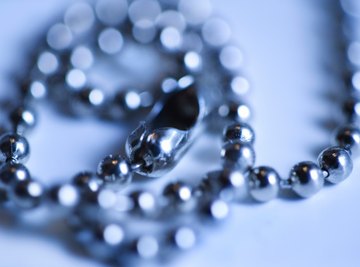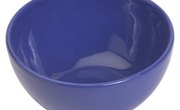
Metallic elements have many different uses in industry, cosmetics and medicine, to name just a few. This family of elements, which includes zinc, copper, silver, iron and gold, has a unique set of characteristics that make them uniquely suited to certain tasks, and many of these elements have been employed in the same way for thousands of years. They interact with various other elements to form chemical compounds -- pure chemical substances that consist of two or more elements that can be divided to form their constituent elements.
Zinc
Zinc is the first element in group 12 of the periodic table; it has an atomic number of 30 and the symbol Zn. Brass, an alloy of copper and zinc, has been used since the 10th century; today, brass is an important alloy used in home appliances where low friction is required (such as with doorknobs and other fixtures) as well as in the production of musical instruments. Other important zinc compounds include zinc carbonate and zinc gluconate, used in dietary supplements (said to ward off the common cold); zinc chloride, used in deodorants to absorb odor; zinc pyrithione in anti-dandruff shampoos; and zinc sulfide, in house paints.
A variety of zinc compounds are commonly used, such as zinc carbonate and zinc gluconate (as dietary supplements), zinc chloride (in deodorants), zinc pyrithione (anti-dandruff shampoos), zinc sulfide (in luminescent paints), and zinc methyl or zinc diethyl in the organic laboratory.
Copper
Copper is also a metallic element; it has the atomic number 29. Copper is used as a conductor of heat and electricity, as a building material and in various metal alloys. Copper salts are some of the most important copper compounds, which give blue and green tints to materials such as turquoise and are frequently used decoratively or as pigments.
Silver
Silver is a metallic chemical element with the atomic number 47 and the atomic symbol Ag (derived from its Indo-European language root arg-, meaning "grey" or "shining"). Silver has the highest electric conductivity of any element and the highest thermal conductivity of all metallic elements. Silver compounds, such as silver nitrate, are used as disinfectants, in anti-microbial agents and in photographic film.
Iron
Iron is a metallic element that has the atomic number 26 and the atomic symbol Fe, taken from "ferrum," the Latin word for iron. It is the fourth most commonly encountered element on the planet Earth. Iron compounds have varied applications. Iron oxide is used in welding and for purifying ores, because when mixed with powdered aluminum it can be ignited to cause a thermite reaction. Hemoglobin and myoglobin, two compounds that act as oxygen-transporting proteins in vertebrate vascular systems, form complexes with iron, giving it an important biological role. Iron compounds are also necessary for cellular respiration, oxidation and reduction in different flora and fauna.
Gold
Gold, with the atomic number 79 and the symbol Au (form the Latin word for gold, "aurum"), is the most malleable and ductile metal element, which means it is the softest and most easily shaped of the family of metallic elements. Gold is also the least reactive metal element and has low toxicity. Gold and gold compounds have important financial symbolism, as many human civilizations have relied on a gold standard to insure their currency. Gold compounds are also used in dentistry (for fillings) and in electronics. Gold is resistant to corrosion and most chemical reactions, and it also conducts electricity, making it an excellent metal for use in electrical wiring and even producing stained glass.
References
About the Author
Goody Clairenstein has been a writer since 2004. She has sat on the editorial board of several non-academic journals and writes about creative writing, editing and languages. She has worked in professional publishing and news reporting in print and broadcast journalism. Her poems have appeared in "Small Craft Warnings." Clairenstein earned her Bachelor of Arts in European languages from Skidmore College.
Photo Credits
Thinkstock/Comstock/Getty Images
